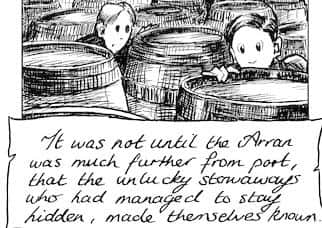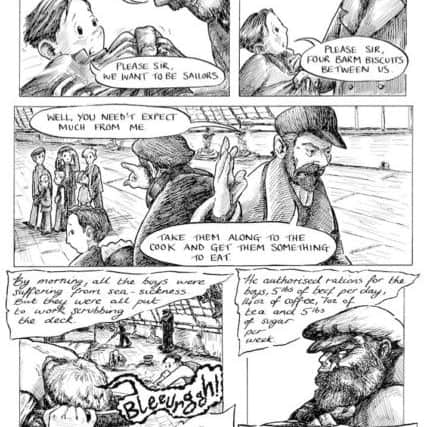The Arran Stowaways: graphic novel revives 150-year-old scandal


The group of seven snuck on the ship at Victoria Dock in Greenock on April 7, 1868 on a journey that was to lead to a national scandal and a murder charge for the captain and his mate.
Hugh M’Ewan, 11, of High Street, Glasgow and John Paul, 11, Hugh M’Ginnes, 12, Peter Currie, 12, James Bryson, 16, David Brand, 16, and Bernard Reilly, thought to be 22, all of Greenock boarded the Arran with a wish to become sailors.
Advertisement
Hide AdAdvertisement
Hide Ad

But they became the “Boys on the Ice” after being thrown off the Arran at the ice fields of Newfoundland, with two of the boys - M’Ewan annd M’Ginnes, not surviving the long, cold scramble to safety.
While the episode led to a sensational trial at the High Court in Edinburgh and the imprisonment of Captain Robert Watt and his brutal mate James Kerr, of Lochranza, Arran, the story of Arran Stowaways has been little told since.
Now a new graphic novel that relives the doomed adventure of the seven west coast boys has been produced by Magic Torch Comics as part of a lottery-funded project, led by Inverclyde Community Trust, to illuminate the rich history of the area.


Paul Bristow, writer and researcher at Magic Torch, said the graphic novel, to be published next month, had been based on the 1928 account of the stowaways by writer and Greenock historian John Donald.
Advertisement
Hide AdAdvertisement
Hide AdMr Bristow said: “This was a very notorious case but there wasn’t an awful lot written about it.
“I have read a lot of books that focus on the history of this area, and a lot of John Donald books, but the Stowaways was not something that was really mentioned very much. It was quite strange.
“After finding John Donald’s account, it was clear that it was a big scandal and a very tragic story.”


Mr Bristow worked with primary children in Greenock to help revive the story.
Advertisement
Hide AdAdvertisement
Hide AdHe said: “Traditional methods of learning history can be off putting for some people but telling it in a visual way can cut through the dates to get straight to the story.
“We really believe in the principle that you dig where you stand, that every community has more than a lifetime of beautiful and tragic stories to share and inspire. We’ve found comics to be a really effective way of engaging less traditional audiences in that process.”
Passages in Donald’s account detail the boys being lashed with thick rope, with Bryson, on one occasion, forced to strip naked before being drenched in freezing water and scrubbed so hard with a deck brush that his skin bled.


Once, having been accused of stealing meal from a barrel, the boys were handcuffed together in irons for 24 hours. Being forced to stand naked on deck was a common punishment.
Advertisement
Hide AdAdvertisement
Hide AdAfter three months of starvation and beatings, the seven were thrown off the Arran at the ice fields of Newfoundland.
The little ones, M’Ginnes, M’Ewan, and Paul, were almost “hysterical with fright” at being told to disembark and find another ship to continue their jounrey, according to Donald.
Some were bare-footed and others in rags, with a single biscuit thrown overboard for each of them to see them on their way.
“So the poor stowaways departed. Excepting the ship, there was nothing but ice, ice, ice all around them, with a grey sky overhead through which the sun’s rays filtered fitfully,” Donald said.
Advertisement
Hide AdAdvertisement
Hide AdThey moved leaping between ice blocks, sometimes using the white wedges as rafts to traverse waterways.
The youngest ones were to die on the ice fields, M’Ewan disappearing underwater and M’Ginnes succumbing to exhaustion.
The five remaining stowaways were rescued shortly after being spotted by a woman on a shoreline.
By this stage, the families of the missing boys were in a state of high anxiety after a letter arrived in Greenock from a townsman in Quebec detailing the trials of the stowaways. No one knew who had died - or who had survived.
Advertisement
Hide AdAdvertisement
Hide AdWord circulated that the Arran was to arrive back on the Clyde on Thursday, July 30, with a large hostile crowd gathering to meet Captain Watt and James Kerr, both who were taken by police from the boat the following day.
Both were charged with murder but Captain Robert Watt was ultimately convicted of culpable homicide following trial in Edinburgh and jailed for 18 months.
James Kerr plead guilty to assault and jailed for four months.
An editorial in the Greenock Telegraph printed shortly after said: “The punishment in each case
Advertisement
Hide AdAdvertisement
Hide Adappears very light, and those in Court who had listened to the evidence heard the sentence in astonishment and greeted its delivery with hisses.”
Only Currie came home to Scotland after the scandal, with others settling in Australia, Canada and North America. Captain Watt and James Kerr returned to the seas after their release from prison.
